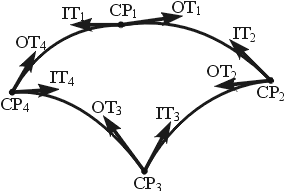
#include <HPatch.h>
Inheritance diagram for HPatch:

Internal Hash Patch is essentially defined by 4 Hermite splines. So there is 8 tangents around a 4 point patch. One in tangent and one Out tangent for each CP.

Relations between In tangents, Out tangents and CPs
Starting with a HPatch, one can walk the splines by first retrieving the HCPs and then using the HCP::GetSpline() function.
Definition at line 53 of file HPatch.h.
|
|
|
|
|
This returns a pointer to the real HAttr in the Model or Group on the HPatch in case a person wanted to take their own samples from a HAttr. |
|
|
On a HPatch there is a HAttr that is a composited attribute using the coordinates (0,0,0). This is what Hash use in real-time. |
|
|
Returns a pointer to the first HCP in the list of 4 CPs that defines the patch.
|
|
|
Returns a pointer to the second HCP in the list of 4 CPs that defines the patch. |
|
|
Returns a pointer to the third HCP in the list of 4 CPs that defines the patch. |
|
|
Returns a pointer to the fourth HCP in the list of 4 CPs that defines the patch. |
|
|
|
|
|
Returns a Vector that is the In tangent to the first HCP in the list of 4 CPs that defines the patch.
|
|
|
Returns a Vector that is the In tangent to the second HCP in the list of 4 CPs that defines the patch.
|
|
|
Returns a Vector that is the In tangent to the third HCP in the list of 4 CPs that defines the patch.
|
|
|
Returns a Vector that is the In tangent to the fourth HCP in the list of 4 CPs that defines the patch.
|
|
|
|
|
|
Returns a Vector that is the Out tangent to the first HCP in the list of 4 CPs that defines the patch.
|
|
|
Returns a Vector that is the Out tangent to the second HCP in the list of 4 CPs that defines the patch.
|
|
|
Returns a Vector that is the Out tangent to the third HCP in the list of 4 CPs that defines the patch.
|
|
|
Returns a Vector that is the Out tangent to the fourth HCP in the list of 4 CPs that defines the patch.
|
|
|
Reimplemented in HPatch5. |
|
|
|
|
||||||||||||||||
|
|
|
||||||||||||
|
|
|
|
If TRUE, the vertex is the last hook on the spline segment |
|
|
|
|
|
|
|
|
|
|
|
If TRUE, means that to traverse to the next vertex you must use GetNext() instead of GetPrev() -- the spline is leading to the next vertex instead of back from it. |
|
|
If TRUE, means that to traverse to the next vertex you must use GetNext() instead of GetPrev() -- the spline is leading to the next vertex instead of back from it. |
|
|
If TRUE, means that to traverse to the next vertex you must use GetNext() instead of GetPrev() -- the spline is leading to the next vertex instead of back from it. |
|
|
If TRUE, means that to traverse to the next vertex you must use GetNext() instead of GetPrev() -- the spline is leading to the next vertex instead of back from it. |
|
|
The vertex is the end of an IsUseHook1 spline segment. |
|
|
The vertex is the end of an IsUseHook2 spline segment. |
|
|
The vertex is the end of an IsUseHook3 spline segment. |
|
|
The vertex is the end of an IsUseHook4 spline segment. |
|
|
If TRUE, this vertex is a hook if IsHookData1 is set then if it is an end hook ( its IsEndHook1 flag is set ), calling GetNextAttached(), will yield the base CP of the spline that the vertex is hooked into. If the vertex is not an end hook, calling GetNextAttached() will yield the next hook down the spline. |
|
|
|
|
|
|
|
|
|
|
|
If TRUE, an adjacent vertex is a hook, or this vertex is a hook. You may not be able to traverse to the next vertex, or the previous from this vertex. If IsUseHook1 is set then if the next vertex's IsHookData1 flag is set, it is a hook, and you cannot traverse to it. another way of getting the Out Tangent "A" must be found 1) The next vertex may be a hook--find out by calling IsHookData1() on it. 1.1) If the next vertex is a hook, then you can determine which direction the connecting spline runs by calling IsEndHook1() on it. If the call returns a true value, then the spline is coming into the current vertex. 2) The previous vertex may be a hook--find out by calling IsHookData1() on it 2.1) If the previous vertex is a hook, then you can determine which direction the connecting spline runs by calling IsEndHook1() to it. If the call returns a true value, then the spline is coming into the currnet vertex. 3) The current vertex may be a hook--find out by calling IsEndHook1() on the current vertex |
|
|
|
|
|
|
|
|
|
|
|
|
|
|
Reverses the normal on the patch. |
Generated on Thu Oct 27 11:46:56 2005 with
![]() 1.4.5 written by Dimitri van Heesch,
© 1997-2001
1.4.5 written by Dimitri van Heesch,
© 1997-2001